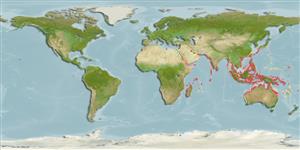Common names from other countries
Environment: milieu / climate zone / depth range / distribution range
Ecologia
marinhas; Água doce; estuarina associadas(os) a recifes; intervalo de profundidade ? - 10 m (Ref. 86942). Tropical; 36°N - 35°S, 20°E - 168°E
Indo-West Pacific: East Africa, Madagascar, Seychelles, Red Sea, Arabian Peninsula, Persian Gulf to India and Andaman Islands; and southeast Asia. Reaches south to the Arafura Sea (Ref. 9819) and northern Australia (Ref. 3131).
Tamanho / Peso / Idade
Maturity: Lm ? range ? - ? cm
Max length : 30.0 cm SL macho/indeterminado; (Ref. 4327)
Espinhos dorsais (total) : 11 - 12; Raios dorsais moles (total) : 9 - 11; Espinhos anais: 3; Raios anais moles: 7 - 9. Body oval, compressed, robust. Lower opercular spine extending well beyond the opercular flap. Post-temporal bone exposed posteriorly and serrate. Color is dusky green above, white below; body, head and fins with an iridescent sheen. Four longitudinal brown stripes extend on the upper side from the head. A large prominent black blotch is on the distal end of the spinous portion of the dorsal fin. Similar brown stripes run across the caudal fin. (from Ref. 3131).
Adults inhabit coastal waters (Ref. 5213). Often found in brackish waters (Ref. 4833). Juveniles with floating weeds, often far offshore (Ref. 48635). Eggs are guarded and fanned by the male parent (Ref. 205). Marketed fresh (Ref. 5284).
Life cycle and mating behavior
Maturities | Reprodução | Spawnings | Egg(s) | Fecundities | Larvas
Eggs are guarded and fanned by the male parent (Ref. 205).
Paxton, J.R., D.F. Hoese, G.R. Allen and J.E. Hanley, 1989. Pisces. Petromyzontidae to Carangidae. Zoological Catalogue of Australia, Vol. 7. Australian Government Publishing Service, Canberra, 665 p. (Ref. 7300)
Categoria na Lista Vermelha da IUCN (Ref. 130435)
Can't connect to MySQL database (fbapp). Errorcode: Too many connections
